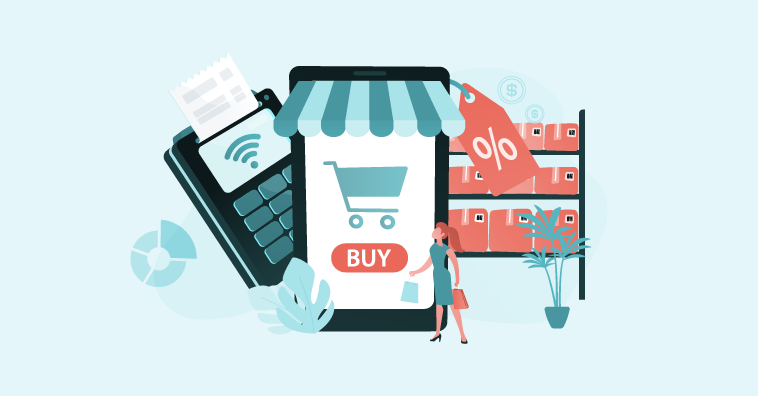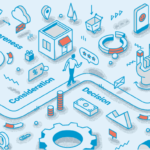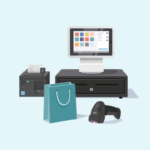What’s the one thing all busy business owners need? More time. Choosing the right point-of-sale (POS) system can streamline your operations and give you more time to run and grow your retail business. Today’s POS systems do more than just process sales transactions; the best also serve as the nerve center of the business, enhancing both behind-the-scenes management as well as customer-facing experiences.
As you evaluate POS systems, put these five key capabilities at the top of the must-have list.
1. Process payments with the greatest of ease.
The history of POS systems dates back to 1879 and the invention of the cash register to calculate and track sales. Nearly 150 years later, POS systems are still central to the purchase process, with payment transactions ranking as a primary consideration when retailers choose a POS for their business.
Your POS system should create a seamless and secure checkout experience, whether customers are shopping in-person or online. Today’s shoppers expect retailers to accept a wide range of payment forms, including the basics like cash, credit, and debit cards, but also gift cards and contactless payments such as Apple Pay or Google Pay. In addition to payment types, look for POS systems that enable you to offer flexibility to customers, such as partial or split payments. Providing options is important. Research shows that more than half of customers won’t make a purchase if their preferred payment method isn’t available.
Payment security is also top-of-mind for customers. Make sure your POS solution complies with the Payment Application Data Security Standards (PA-DSS), which provide guidelines for how customer payment data is accepted, processed, and what is and isn’t stored. Compliance with the standards enhances the security of payment data and reduces fraud.
2. Manage your inventory end-to-end.
Effective inventory management provides critical insights into your business and should be a primary factor when evaluating POS systems. The inventory management tools within your POS should give you an all-in view of your stock by centralizing your data across brick-and-mortar and e-commerce channels.
Expect your POS system to go beyond the basics of tracking purchases and linking them to your in-stock inventory. It should also help you streamline the most complex inventories and enable you to accurately track products with multiple style attributes. Plus, look to your POS for specialized inventory management capabilities to fit your business, such as the ability for fabric stores to track items by the yard or short bolts, or for wine and liquor retailers to track inventory by the case or single bottles.

The best POS systems also save you time with automated inventory management functionality like uploading and adding multiple items at once, setting low-stock alerts and re-order triggers, printing custom barcode labels, and tracking serialized inventory. With these fundamentals in place, you can ensure the most popular products are always available and identify underperforming items. Real-time access to inventory data helps you develop accurate forecasts, make informed buying decisions, and maintain a healthy cash flow.
Related: Optimize Your Inventory: Debunking the Myths about Inventory Management
3. Integrate all-around.
Making your POS system the nerve center for your business means integrating your sales, inventory, and customer data across physical and e-commerce channels. When the data is centralized, you’re better able to leverage it to deliver enhanced shopping experiences for customers, whether in-person or online. Integrated data gives you views into customer trends, sales volume detail, and inventory status. For example, use insights from the consolidated data to bundle popular products with under-selling items or create exclusive loyalty-program promotions.
Centralizing your data within your POS puts customer profile information at your sales team’s fingertips, so they’re able to personalize the in-store shopping experience. It also enables you to build “you may also like” suggestions into your e-commerce channel. Go a step further to integrate your POS with your email marketing platform, such as Mailchimp, so you can easily communicate with customers, share news, and announce promotions.
Related: How to Improve Customer Experience Using POS Data
4. Go mobile.
Ensuring you and your team can access your POS system on-the-go is essential. Mobile POS means you’re able to look up inventory, answer questions, and process payments without leaving the customer’s side, no matter where they are in the store. It’s the ultimate in personalized shopping convenience.
In addition, mobile POS simplifies the inventory process and day-to-day management. As you walk around the store, mobile POS capabilities enable you to scan shelf tags to access real-time, detailed information about products and available stock. Plus, you can easily update item counts, adjust quantities, or edit prices, all from your mobile device.
5. Make data-driven decisions.
For retailers, having easy access to integrated data is powerful. But, while retailers are compiling more data than ever before, an estimated 73 percent goes unused. Leverage your POS system to optimize your data and produce automated, standard reports that bring information together and make it more actionable.
Along with regular sales and inventory turnover reports, consider creating automated reports to identify best-selling and under-performing products, as well as your best customers, new customers, and those who haven’t purchased in a while. By regularly monitoring your data, you’ll uncover data-based insights, understand purchasing patterns, and drive increased sales.
Related: Turn Your Retail Data into a Competitive Advantage
POSIM is a point-of-sale and inventory management system that helps you harness your data, personalize customer interactions, and add efficiencies to your operations. Find out what’s possible with POSIM. Contact us for a demo today.











